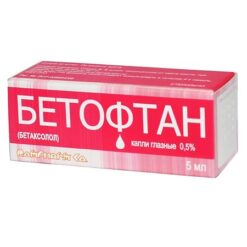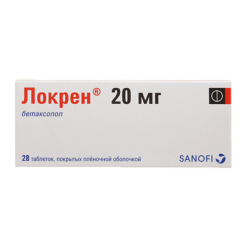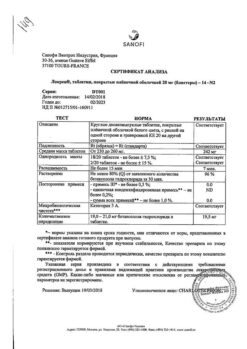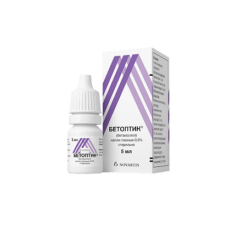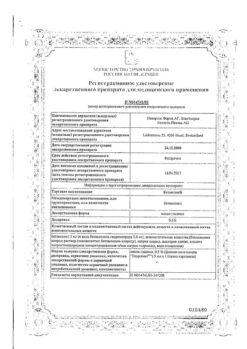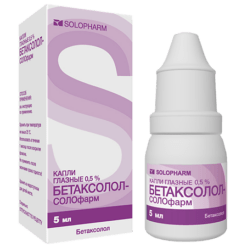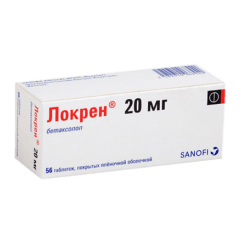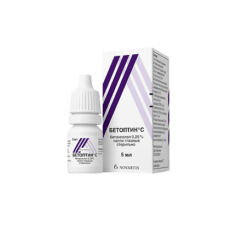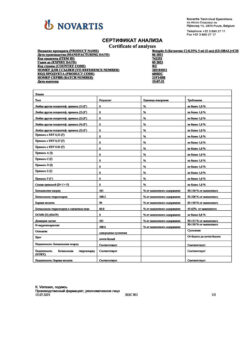No products in the cart.
Betaxolol, 20 mg 30 pcs.
€16.31 €13.59
Description
A cardioselective beta1-adrenoblocker without intrinsic sympathomimetic activity. It has weak membrane stabilizing activity.
It has hypotensive effect associated with decreased cardiac minute volume and decreased sympathetic stimulation of peripheral vessels.
When used in therapeutic doses it does not have cardiodepressant effect, does not affect glucose metabolism, does not decrease the bronchodilator effect of beta-adrenomimetics and does not cause delay of sodium ions in the body. It works for a long time.
When used topically in the form of eye drops it reduces the increased intraocular pressure. The resorptive effect is expressed only slightly.
Indications
Indications
For systemic use: arterial hypertension.
For local use in ophthalmology: chronic open-angle glaucoma, increased intraocular pressure, condition after laser trabeculoplasty.
Active ingredient
Active ingredient
Composition
Composition
active ingredient:
betaxolol hydrochloride – 20 mg;
auxiliary substances, including the composition of the shell:
lactose monohydrate,
sodium starch glycolate,
p> colloidal anhydrous silica,
magnesium stearate,
microcrystalline cellulose,
polyvinyl alcohol,
titanium dioxide E 171,
talc,
macrogol/PEG 3350,
lecithin (soy).
How to take, the dosage
How to take, the dosage
For systemic use when administered orally, 20 mg once daily.
For patients on permanent hemodialysis or peritoneal dialysis the initial dose is 10 mg/day; the time of betaxololol administration is established regardless of the dialysis session regimen.
For topical use in ophthalmology, 1 drop 2 times daily into the affected eye.
In the first month the therapy is carried out under control of intraocular pressure level; after this time the frequency of intraocular pressure measurement is determined individually.
If betaxololol is used after previous treatment with another similar drug, the dosing regimen is determined individually.
Interaction
Interaction
Concomitant use with adrenomimetics, xanthine derivatives decreases the effectiveness of betaxolol.
Concomitant use with antacids and antidiarrheals may decrease the absorption of beta-adrenoblockers.
Concomitant use with antihypertensive agents increases the antihypertensive effect.
Concomitant use of halogen-containing agents for inhalation anesthesia may increase the negative inotropic effect.
The concomitant use of nondepolarizing myorelaxants may increase their duration of action.
The simultaneous use of NSAIDs, GCS decreases the antihypertensive effect of betaxolol.
The concomitant use of cardiac glycosides may increase bradycardia.
The concomitant use of tricyclic antidepressants (imipramine) decreases BP, there is a risk of orthostatic hypotension.
Concomitant use of amiodarone, verapamil, diltiazem, beta-adrenoblockers for topical use in glaucoma may increase negative inotropic effects and impair conduction.
The concomitant use of lidocaine increases plasma lidocaine concentrations.
Concomitant use with catecholamine depleting drugs (including reserpine) may increase the hypotensive effect and bradycardia.
Concomitant use with sulfasalazine increases plasma concentrations of betaxolol.
Special Instructions
Special Instructions
It is not recommended to use in bronchial asthma, chronic bronchitis with bronchoobstructive syndrome.
With caution is used in diabetes mellitus, suspected thyrotoxicosis, with indication in the anamnesis of bronchial hyperresponsiveness, in patients with AV-blockade of degree I, Raynaud’s syndrome, pheochromocytoma.
When administered orally in hepatic insufficiency, as well as in renal insufficiency (CK less than 20 ml/min) there is no need to adjust the dosing regimen, but regular clinical observation is recommended during the first few days of treatment.
In the first days of treatment, the possibility of symptoms of heart failure in predisposed patients should be considered. Withdrawal of betaxolol should be done gradually, especially in patients with CHD, angina pectoris.
Betaxolol does not affect pupil size, so in closed-angle glaucoma the drug should be used only in combination with myotics. If a patient is switched to betaxolol after treatment with several antiglaucoma drugs, the latter should be withdrawn gradually, within at least 1 week per drug.
Concomitant use of betaxolol in the form of eye drops and oral beta-adrenoblockers may result in additive effects of both intraocular pressure and the systemic effects of beta-adrenoblockers.
Beta-adrenal blockers, including betaxolol, should be stopped before elective surgery.
When using betaxololol topically, contact lenses should not be worn.
The use of betaxololol in children is not recommended.
Impact on driving and operating ability
Perhaps with caution in patients whose activities require increased attention and rapid psychomotor reactions.
Contraindications
Contraindications
Cardiogenic shock, severe forms of chronic heart failure, AV blockade of II and III degree, CCSU, sinoatrial block, sinus bradycardia, severe peripheral circulatory disorders, hypersensitivity to betaxololol.
Side effects
Side effects
Cardiovascular system disorders: at the beginning of treatment – AV-blockade, sinus bradycardia, arterial hypotension, heart failure, Raynaud’s syndrome.
Digestive system disorders: rarely – abdominal pain, nausea, vomiting.
CNS and peripheral nervous system disorders: at the beginning of treatment – asthenia, paresthesia of extremities, sleep disorders, depression, somnolence, dizziness.
Respiratory system: rarely – bronchospasm.
Allergic reactions: rarely – psoriasis-like skin manifestations.
Local reactions: when used in the form of eye drops immediately after injection, transient eye discomfort and sometimes lacrimation are possible; rarely – decreased corneal sensitivity, erythema, itching, corneal staining, keratitis, anisocoria, photophobia.
Similarities
Similarities
Additional information
| Manufacturer | Moscow Endocrine Plant, Russia |
|---|---|
| Medication form | pills |
| Brand | Moscow Endocrine Plant |
Other forms…
Related products
Buy Betaxolol, 20 mg 30 pcs. with delivery to USA, UK, Europe and over 120 other countries.


